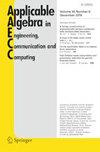A note on the Assmus–Mattson theorem for some ternary codes
IF 0.6
4区 工程技术
Q4 COMPUTER SCIENCE, INTERDISCIPLINARY APPLICATIONS
Applicable Algebra in Engineering Communication and Computing
Pub Date : 2024-04-09
DOI:10.1007/s00200-024-00654-6
引用次数: 0
Abstract
Let C be a two and three-weight ternary code. Furthermore, we assume that \(C_\ell \) are t-designs for all \(\ell \) by the Assmus–Mattson theorem. We show that \(t \le 5\). As a corollary, we provide a new characterization of the (extended) ternary Golay code.
关于某些三元码的阿斯穆斯-马特森定理的说明
假设 C 是二重和三重三元码。此外,根据阿斯穆斯-马特森定理,我们假设\(C_\ell \)是所有\(\ell \)的t-指定。我们证明了(t (ell 5))。作为推论,我们提供了(扩展的)三元戈莱码的新特征。
本文章由计算机程序翻译,如有差异,请以英文原文为准。
求助全文
约1分钟内获得全文
求助全文
来源期刊
CiteScore
2.90
自引率
14.30%
发文量
48
审稿时长
>12 weeks
期刊介绍:
Algebra is a common language for many scientific domains. In developing this language mathematicians prove theorems and design methods which demonstrate the applicability of algebra. Using this language scientists in many fields find algebra indispensable to create methods, techniques and tools to solve their specific problems.
Applicable Algebra in Engineering, Communication and Computing will publish mathematically rigorous, original research papers reporting on algebraic methods and techniques relevant to all domains concerned with computers, intelligent systems and communications. Its scope includes, but is not limited to, vision, robotics, system design, fault tolerance and dependability of systems, VLSI technology, signal processing, signal theory, coding, error control techniques, cryptography, protocol specification, networks, software engineering, arithmetics, algorithms, complexity, computer algebra, programming languages, logic and functional programming, algebraic specification, term rewriting systems, theorem proving, graphics, modeling, knowledge engineering, expert systems, and artificial intelligence methodology.
Purely theoretical papers will not primarily be sought, but papers dealing with problems in such domains as commutative or non-commutative algebra, group theory, field theory, or real algebraic geometry, which are of interest for applications in the above mentioned fields are relevant for this journal.
On the practical side, technology and know-how transfer papers from engineering which either stimulate or illustrate research in applicable algebra are within the scope of the journal.

 求助内容:
求助内容: 应助结果提醒方式:
应助结果提醒方式:


